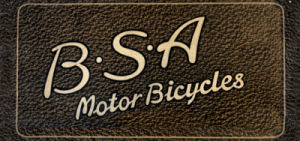


Despite its adequate mudguarding and complete chain cases, the new sporting B.S.A. has a very speedy and rakish appearance.
Broadside view of the "light six" - an excellent double purpose mount.
An entirely new B.S.A. model - the 8 h.p. sidecar outfit.
THE B.S.A. RANGE FOR 1922.
Three New Models: A "Light Six," an 8 h.p. Twin, and a Sporting Single.
IN addition to its already well-known types, the B.S.A. Co. has decided to list three new machines, which differ in detail only from present standards.
An 8 h.p. long-stroke engine (80x98 mm. = 985 c.c.) will replace the standard touring 6 h.p. in a machine of almost identical specification. The B.S.A. interchangeable wheels, cast aluminium chain cases, and ample mudguarding, are, of course, retained; but, in addition, a Brooks B600 saddle will be standardised, and a long shoe brake operating in a dummy belt rim will be added. Thus, with the standard expanding rear wheel brake and the front belt rim brake, three methods of retarding the machine will be provided. A further modification consists of screwed nipples in forks and hubs to take the end of a screw-down grease gun.
28x3in. tyres are used. The engine is a larger edition of the 6 h.p. model, and embodies the oscillating mechanical oil pump introduced by the firm ; in fact, with the exception of a slight modification in the timing gear, and an increase in cylinder dimensions, the engines are practically identical. A luxurious sidecar,with a strongly constructed chassis and very large luggage accommodation, is attached.
The Light 6 h.p. Twin.
The 6 h.p. engine has proved such a success that it is not to be dropped ; but it will be fitted to a lighter frame a modification of the 4 ¼ h.p. frame end will be known in future as the " light six." Fitted with the same sidecar body as the 8 h.p., but with a simplified chassis, or with a sporting sidecar, the machine retains most of its original features, except that the wheels, though readily detachable, are not interchangeable; 25x3in. tyres are employed. No expanding rear brake is fitted in this case.
The "light six," which made its debut in the Six Days Trials in the hands of M. C. Breese, is a compact and handy machine, which should be a fast and comfortable solo mount for those who prefer high power.
A third novelty is the Sports model "four-and-a-quarter," which may be obtained either solo or attached to an attractive-looking sidecar of the sporting variety.
Except for the substitution of footrests for footboards, and the fitting of wide handle-bars, the machine outwardly resembles the standard single ; but the piston and connecting rod have been lightened, and lighter flywheels with polished rims are employed. Normally, only one pair of footrests is fitted, but provision is made for a secondpair, which also forms an additional sidecar connection. A long, oblong section silencer with dual exit pipes is fitted below the chain stay in place of the usual expansion chamber in front of the engine.
The 4¼ h.p. all-chain and chain-cum-belt models remain as before, so that the manufacturers now cater for all types of motor cyclist, except the lightweight rider. As usual, the finish of the new machines is in keeping with the reputation of the firm.
Of the sidecars, that fitted to the 8 h.p. machine is very roomy and well upholstered, and, in addition to a large locker, there is a luggage platform behind the seat. The springing is most luxurious, and a sturdy chassis is used. At the opposite end of the line comes the simple chassis and streamline shell of the sporting model, which nevertheless offers considerably greater comfort than might be expected from such a racy-looking contrivance.
The Motor Cycle October 13th, 1921.